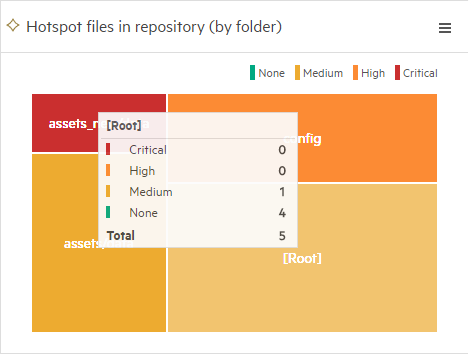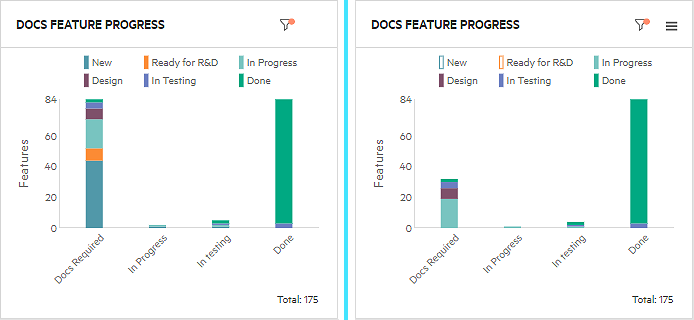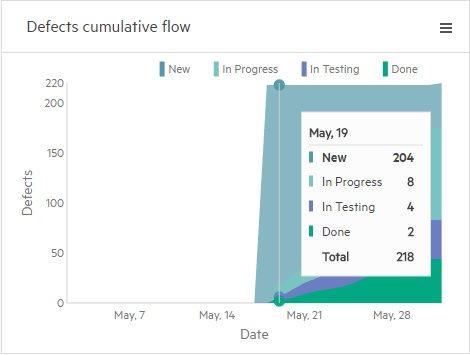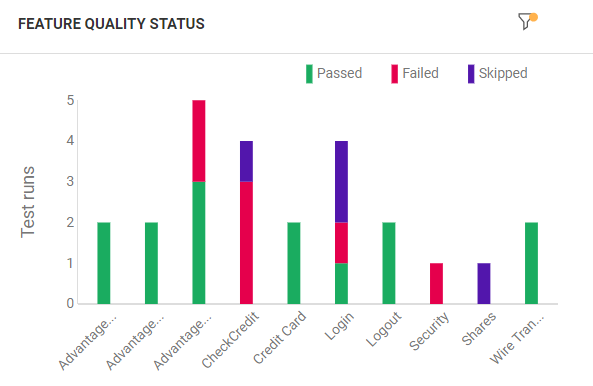ALM Octane dashboard
The ALM Octane dashboard is the control center for analysis. It gives a visual, customizable display of development progress and quality.
In this topic:
- What is the dashboard?
- Set up the dashboard
- Configure widget data settings
- Use dashboard widgets for analysis
- Performing quality analysis
- Traceability graphs
- Save dashboards as favorites
- Export widget data and images
What is the dashboard?
The dashboard is a collection of widgets displaying data about development progress and quality, including widgets for:
-
Tracking progress
-
Quality
-
Content Planning
-
Test Coverage
-
DevOps and Analytics
If the out-of-the-box widgets are not enough, create a custom widget to display your data.
Tip: Perform similar analysis in the Quality and Backlog modules, in the Overview tab and in the Pipelines module's main page.
Also, with OData support, you can generate sophisticated reports that directly access ALM Octane entities. For details, see OData support for extended reporting.
Customize the graphs, including the type of data reported, the scope and time frame, the widget groups and the displays of the data.
You can also configure how you want to view widgets and save different widgets as favorites.
Set up the dashboard
In the ALM Octane banner, click the menu button ![]() and select Dashboard or select the Overview tab in the Backlog/Quality modules.
and select Dashboard or select the Overview tab in the Backlog/Quality modules.
-
In the toolbar, click the Add Widget + button.
-
In the Widget Gallery, select a category and a widget within the category or click Add custom graph. Use the tabs in the Widget Editor to set up and configure your widget.
Tip: Are you not really sure which widget to use? Read the description of the widget to see which questions this widget helps you answer.
-
Click Add to Dashboard. ALM Octane adds the widget at the bottom of the dashboard.
-
Repeat as necessary to suit your needs.
-
In the toolbar, click the Dashboard layout
 button and select the necessary layout. Drag and drop widgets as needed.
button and select the necessary layout. Drag and drop widgets as needed.
ALM Octane maintains the specific widgets and layout between sessions.
To clear the widgets on the dashboard and start again, click the Clear Dashboard  button.
button.
Note: When the top section of a layout is empty you will see a large gap, to enable you to drag widgets easily into the section. If you plan to leave it empty you might want to consider using a different layout.
Configure widget data settings
After you have set up the Dashboard widgets, you need to configure the data settings for each widget.
-
In the right corner of the widget, click the vertical ellipsis and select Configure.
Tip: If you want to duplicate a current widget configuration as a starting point, in the widget menu, select Duplicate. ALM Octane adds a widget named Copy of <Widget Name>.
-
In the General tab, select the graph type and update the name and description as needed. For non-Agile graphs, choose Current Status or Status Over Time.
-
In the Scope tab, define the scope of the data to display, including:
-
These are the workspaces from which ALM Octane should compile the graph's data. To use this field, the workspace must be associated with a shared space.
Enterprise edition: Using this field, you can define dashboard widgets that display cross-workspace information.
Choose All my workspaces to compile data from all workspaces in which I am a member. The Workspace field is not supported for agile graphs, such as the Burn Up, Burn Down, Edit Release Forecast, and Cumulative Flow graphs.
-
Item type
Dropdown item types change depending on what kind of widget you are configuring. See the table below for more details.
Item type Description Tests Includes all subtypes of tests - manual tests, automated tests, Gherkin tests, BDD scenarios and test suites.
For details on the testing frameworks and test types available in ALM Octane, see Testing and Manual testing flow.
Last runs Includes only the last runs of all types of runs (manual run, automated run, suite run, Gherkin automated run). Popular use case: status and coverage analysis based on selected program, release, milestone, environment.
For details on how Octane identifies runs as last runs see Run manual and Gherkin tests
Test run history (automated) Includes all historic automated runs of automated tests, Gherkin tests, and BDD scenarios. The trends of failure ratio is a popular use case.
For details see Trigger automated test runs in your testing framework.
Test run history (manual) Includes all manual runs of manual tests, Gherkin tests and BDD scenarios. Tracking manual run progress is a popular use case.
Test run history (suites) Includes all suite runs. For details see Plan and run test suites. Pipeline run Includes all pipeline runs, which represent the builds of all root jobs that were defined as pipelines.
For details see Automated testing flow (pipelines).
- Release
- Sprint
- Milestone
-
-
For trend-based graphs (Status Over Time), specify a time frame:
Without a release specified If you select:
-
the All <items> up to now option, the graph contains every item of the selected type from the beginning of your project until now.
-
A specific period, the scope (last 24 hours, last 7 days, and so on) means last <time period> up to now. For example, the "Last week" means the previous week until now.
With a release specified If you select:
-
All <items> up to now, the graph includes the selected item type from the beginning of the specified release until now.
-
Release period, the graph includes the selected item type from the start date to the end date of the release.
-
All {items} up to end of release, the graph includes items created or updated from the beginning of the project until the end of the release.
-
All {items} from start of release up to now, the graph includes items created or updated from the start date of the release until now.
Note: When using trend based graphs (for example, Burn Up or Burn Down charts), if one of the sprints includes a day with a clock change, the graph tooltips exclude the day, week, or month with the time change. The excluded period depends on the scope you set in the graph configuration.
For example, if a sprint includes the day the clock switches to Daylight Savings time, the tooltips exclude this day, week, or month.
-
-
Define additional conditions for filtering dashboard widgets, in the Scope tab.
For example, if you only want to show defects that had a phase age of 60 days or more, add a Days in phase filter and specify Greater than 60.
If you select more than one workspace in the Workspaces field, filters display the fields common to all selected workspaces. Certain reference fields (such as Application Modules or Features) are not available for use in cross-workspace graph filters.
If you update the workspaces that are selected or open the same graph in a different workspace, ALM Octane clears the existing filters. For details, see Define filters.
-
In the Display tab, set the display options, including what to display on the x-axis and y-axis of the graph, and how to group the displayed data. Use the following options:
Double height Display a widget in an extra-long vertical format. By default, grids are displayed as double-height.
Grid format Summary graphs can be displayed in a grid format. (trend-based graphs cannot be displayed as a grid.) Each graph source such as defects or tests has default columns defined, which you can change as needed.
-
The grid limit is the maximum number of rows displayed, from 0 (no limit) to 100. The default is 25 rows.
-
When setting up a grid, you can select up to two fields for sorting. These fields correspond with the x-axis and group-by fields of graphs. If you select a field that cannot be used for sorting, an informational message appears in a tooltip next to the field name.
-
On some grids (depending on source type), you can drill down into the grid rows to view full entity details.
Tip: Grid widgets can display cross-workspace information. For example, you can show the highest-severity defects from all workspaces in a shared space (Enterprise edition).
Include empty columns In some graphs, you can include data from features or application modules with no associated or assigned items. To do so, select Include empty columns in graph.
Show trend of changes Counts all status changes in a given time-frame, and not only the final state of each entity. For example, suppose you want to see how many defects were opened and closed in each day, giving you a picture of the overall trend. You can use the Defect daily injection days/weeks graph to see how many defects were opened and closed by your team, over a two-week period.
When aggregating per weeks, the number for each date on the graph represents how many records were at the end of the week that started on the start date. -
-
To export data with full report data as if it were a graph, independent of the grid filtering settings, click the vertical ellipsis in the top corner of the widget, and click Export Report.
-
Click Save. ALM Octane updates the graph according to your selections.
Use dashboard widgets for analysis
After you add and configure widgets, use them to perform in-depth analysis:
| View more details |
For the different sections in a graph, hover over the section to see a tooltip with details:
|
| Open referenced items |
Click on a section of a graph to display and drill down on the items referenced in the sections of the graph. View items in a grid or in a smart list. You can sort, filter, group by, and search for items. In grid view, you can add or remove columns. Display and drill down on reference items (such as features or application modules) is not available for trend-based graphs. |
| Hide/Show data |
Click an item in the widget's legend to show or hide data in the widget. Example: In the widget on the left, we clicked New and Ready for R&D to hide features that are not yet ready to be documented. On the right, the items are hidden, and you can see that the widget items are not selected.
|
| Read values along the timeline |
For trend-based graphs, drag the mouse along the trend line to see a period-by-period detail:
|
Performing quality analysis
You can check the quality of the application development.
In the Dashboard module, add widgets to assess quality:
|
Feature quality status This enables you to see how much testing has been completed on your features. You can also analyze the quality of the features by reviewing the number of runs according to status. |
|
|
Open defects by feature This graph enables you to see the outstanding defects for each feature and their severity. In so doing, you understand their current quality. |
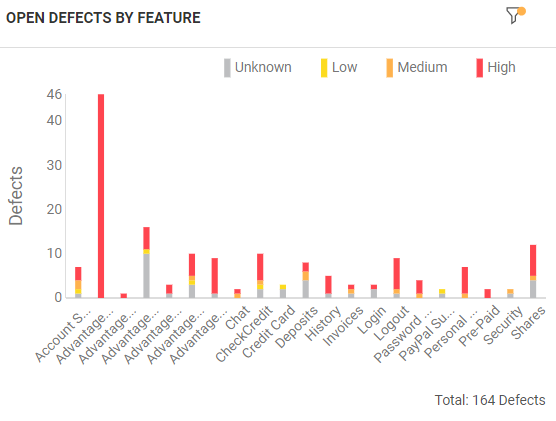
|
|
Features by risky commits This graph enables you to recommend further regression testing before finishing the release. |
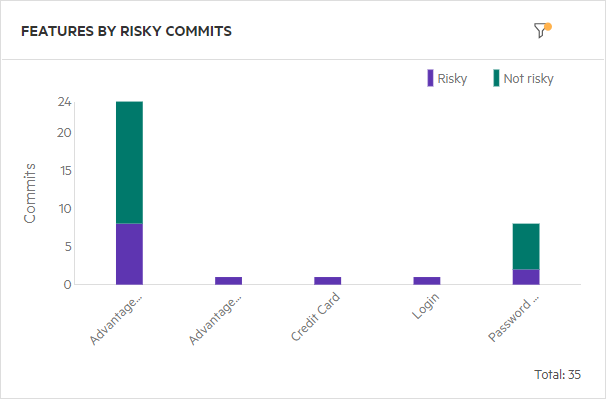
|
|
This graph enables you to see the quality of each area of the application. You can configure the Criteria to use to determine the level of quality. For example, you can use the number of defects, percentage of failed tests, or percentage of risky commits. |
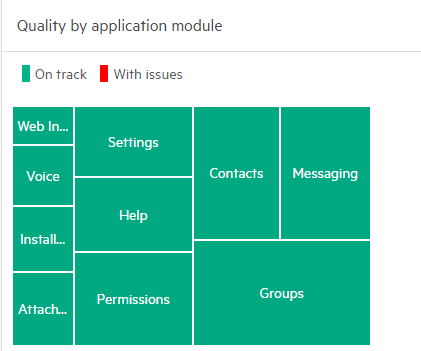
|
Traceability graphs
The Traceability graph widget reflects relationships between a selected primary entity and a secondary entity. You can set filters both on the primary and the secondary elements.
For example, you can use traceability graphs to see the following:
-
All the requirements of a particular release, and all the tests that cover them.
-
All of your team’s features and the defects that cover them.
-
Requirements that are traced to/from a set of requirements.
To see requirements or features that do not have test coverage, use the filter to only include those without a relation.
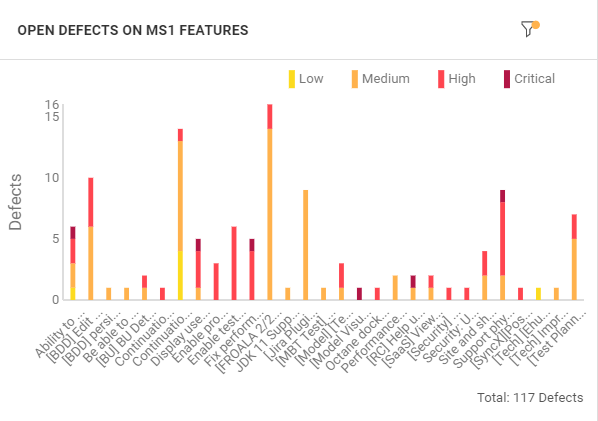
Save dashboards as favorites
You can save a dashboard as a favorite. This allows you to maintain several dashboards, and lets you share them with other members of your workspace.
To save and share a dashboard within the workspace:
- In the top banner, expand the Favorites menu
 and select Save New Favorite.
and select Save New Favorite. - Specify a name for the favorite.
- To save a dashboard under My Favorites for personal use, make sure all the checkboxes are cleared and click Save.
-
To save the dashboard in order to share it with others, specify the scope:
- Share with all to add it to Public Favorites.
- Share with teams to add it to My Team Favorites.
Click Save.
To manage your favorites:
Click the vertical ellipsis to open the widget's menu, and select Export Report or Export Image.
- In the top banner, expand the Favorites menu
 and select Load/Manage.
and select Load/Manage. - Select a category in the left pane to view the favorite that you want to manage.
- Hover over the favorite and select Delete, Share, or Copy link.
To load a favorite:
You can load dashboards that were saved as personal, team, or public favorites.
- In the top banner, expand the Favorites menu
 and select Load/Manage.
and select Load/Manage. - Select a category in the left pane: My Favorites, My Team Favorites, or Public Favorites.
- Filter or sort the favorites, or search for one by the name of the user who shared it.
- Hover over the favorite and click Load.
Export widget data and images
In summary dashboard widgets, you can export the widget's raw data or image to an .xls or .png file, respectively.
- Click the vertical ellipsis
 in the graph's top corner.
in the graph's top corner. - Select Export Report or Export Image.
 See also:
See also:







